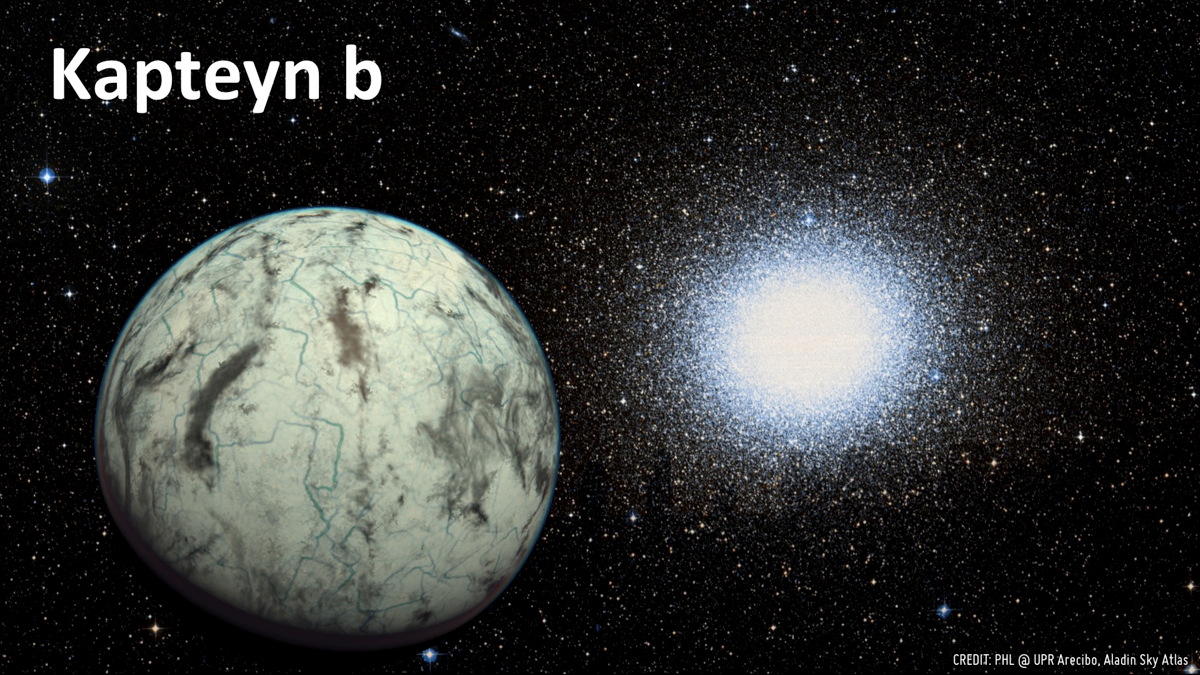
Astronomers have discovered what appears to be the oldest known alien world that could be capable of supporting life, and it's just a stone's throw away from Earth.
The newfound exoplanet candidate Kapteyn b, which lies a mere 13 light-years away, is about 11.5 billion years old, scientists say. That makes it 2.5 times older than Earth, and just 2 billion years or so younger than the universe itself, which burst into existence with the Big Bang 13.8 billion years ago.
"It does make you wonder what kind of life could have evolved on those planets over such a long time," study lead author Guillem Anglada-Escude, of Queen Mary University of London, said in a statement. [10 Exoplanets That Could Host Alien Life]
Anglada-Escude was referring to Kapteyn b and its newly discovered sister world, Kapteyn c, which both orbit a nearby red dwarf known as Kapteyn's Star. But only Kapteyn b, a "super-Earth" about five times as massive as our own planet, is thought to be potentially habitable; the larger Kapteyn c is likely too cold, researchers said.
The astronomers spotted both alien planets by noting the tiny wobbles their gravitational tugs induced in the motion of Kapteyn's Star. These tugs caused shifts in the star's light, which were first detected using the HARPS spectrometer at the European Southern Observatory's La Silla Observatory in Chile. Further observations by two other spectrometers — HIRES at the Keck Observatory in Hawaii and the PFS instrument at Chile's Magellan II Telescope — backed up the finds.
The team didn't expect to find a possibly habitable world around Kapteyn's Star, which is one-third as massive as the sun but so close to Earth that it's visible in amateur telescopes, in the southern constellation of Pictor.
"We were surprised to find planets orbiting Kapteyn's Star," Anglada-Escude said. "Previous data showed some moderate excess of variability, so we were looking for very short-period planets when the new signals showed up loud and clear."
Get the Space.com Newsletter
Breaking space news, the latest updates on rocket launches, skywatching events and more!
Kapteyn b lies in the star's habitable zone, the range of distances that could support liquid water — and thus, perhaps, life as we know it — on a world's surface. The exoplanet completes one orbit every 48 days. The colder Kapteyn c is much farther out, circling the star once every 121 days.
Adding to the intrigue is the strange history of the Kapteyn system. The star originally belonged to a dwarf galaxy that our own Milky Way eventually absorbed and disrupted, researchers said, throwing Kapteyn and its planets into their speedy, elliptical orbit in the galactic "halo" — the region surrouding the Milky Way's familiar spiral-armed disk.
The remnant of this gobbled-up dwarf galaxy is likely Omega Centauri, a globular cluster about 16,000 light-years away that contains many thousands of stars that are around 11.5 billion years old, researchers said.
"The presence and long-term survival of a planetary system seems a remarkable feat given the peculiar origin and kinematic history of Kapteyn’s star," the researchers write in the new study, which will be published in the Monthly Notices of the Royal Astronomical Society. "The detection of super-Earth mass planets around halo stars provides important insights into planet-formation processes in the early days of the Milky Way."
The new discovery is an exciting one that could inform the search for alien life throughout the galaxy, outside researchers said.

"It suggests that many potentially habitable worlds will be found in the next years around nearby stars by ground-based and space-based observatories such as ESA's PLATO mission," said Richard Nelson of Queen Mary University of London, who was not a part of the study team. "Until we have detected a larger number of them, the properties and possible habitability of the near-most planetary systems will remain mysterious."
Follow Mike Wall on Twitter @michaeldwall and Google+. Follow us @Spacedotcom, Facebook or Google+. Originally published on Space.com.
Join our Space Forums to keep talking space on the latest missions, night sky and more! And if you have a news tip, correction or comment, let us know at: community@space.com.

Michael Wall is a Senior Space Writer with Space.com and joined the team in 2010. He primarily covers exoplanets, spaceflight and military space, but has been known to dabble in the space art beat. His book about the search for alien life, "Out There," was published on Nov. 13, 2018. Before becoming a science writer, Michael worked as a herpetologist and wildlife biologist. He has a Ph.D. in evolutionary biology from the University of Sydney, Australia, a bachelor's degree from the University of Arizona, and a graduate certificate in science writing from the University of California, Santa Cruz. To find out what his latest project is, you can follow Michael on Twitter.